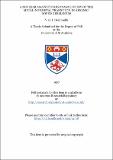Files in this item
A nuclear magnetic resonance study of the metal-nonmetal transition in arsenic-doped germanium
Item metadata
| dc.contributor.advisor | Tunstall, D. P. (David Prestwich) | |
| dc.contributor.author | Deshmukh, V. G. I. | |
| dc.coverage.spatial | 258 p. | en_US |
| dc.date.accessioned | 2018-06-28T14:21:06Z | |
| dc.date.available | 2018-06-28T14:21:06Z | |
| dc.date.issued | 1977 | |
| dc.identifier.uri | https://hdl.handle.net/10023/14718 | |
| dc.description.abstract | An investigation of the metal-nonmetal transition in arsenic-doped germanium (Ge;As) has been performed using the technique of nuclear magnetic resonance. The host Ge⁷³ resonance has been observed in twelve, single crystal, uncompensated specimens with room-temperature carrier concentrations from 7.10¹⁶-1.75.10¹⁹cm⁻³. Measurements of the nuclear spin-lattice relaxation time T₁, Knight shift K and the nuclear linewidth △B for Ge⁷³ are reported. Specifically, data are given at and below liquid helium temperatures for an applied magnetic field of 1. 44T and at 4.2K alone at a field of 5T. The Knight shifts have been measured at 4.2K at 5T and values of △B are given for both fields at 4.2K. The T₁ measurements at low field (1.44T) and Knight shift results show donor density dependences of free-electron type. A strong field dependence of T₁ has however been observed which is inexplicable by free-electron theory. The resonance linewidths are greater than the nuclear dipolar value, even for non-metallic samples, and increase with doping density and magnetic field. At the critical concentration for transition to metallic behaviour K shows an abrupt change from zero to a finite value. The low-field T₁'s are in contrast continuous across the transition but the high-field T₁'s do show a sharp increase below the critical doping density. A calculation shows spin diffusion to be unimportant for the samples and other mechanisms which can generate a field-dependent relaxation time are discussed. Firstly, assuming that the electrons form a homogeneous system and are confined to a narrow impurity band parameterised by an appropriate Bohr radius leads to a field dependence of T₁ in order of magnitude agreement with the data. A second qualitative model in line with recent ideas on the origin of negative magnetoresistance in doped semiconductors invokes the presence of nearly-free moments or Kondo centres in addition to the itinerant electron system. The fluctuation of the moments can furnish a relaxation process in addition to that due to Fermi contact between band electrons and nuclei. An increase in magnetic field inhibits the moment fluctuation rate and thus increases with field. Moreover the presence of moments will lead to resonance line broadening as we have observed. Finally, the magnetic properties of an Anderson transition are discussed and the abrupt appearance of K is shown to be consistent with Mott's interpretation of an Anderson transition. An important overall result is that the electron-electron effects observed in Si:P are absent in the Ge:As system. Simple estimates show that the intra-atomic correlation energy is smaller in n-Ge than n-Si and it is concluded that the metal-nonmetal transition in Ge:As is of Anderson-type and that correlation plays no essential role. This proposal is shown to be in agreement with the results of other experiments in heavily-doped Ge. | en_US |
| dc.language.iso | en | en_US |
| dc.publisher | University of St Andrews | |
| dc.subject.lcc | QD181.G5D3 | |
| dc.subject.lcsh | Germanium | en |
| dc.title | A nuclear magnetic resonance study of the metal-nonmetal transition in arsenic-doped germanium | en_US |
| dc.type | Thesis | en_US |
| dc.contributor.sponsor | University of St Andrews | en_US |
| dc.type.qualificationlevel | Doctoral | en_US |
| dc.type.qualificationname | PhD Doctor of Philosophy | en_US |
| dc.publisher.institution | The University of St Andrews | en_US |
This item appears in the following Collection(s)
Items in the St Andrews Research Repository are protected by copyright, with all rights reserved, unless otherwise indicated.

